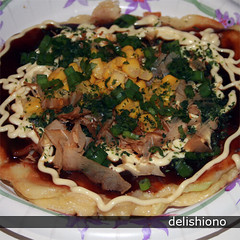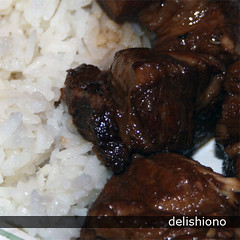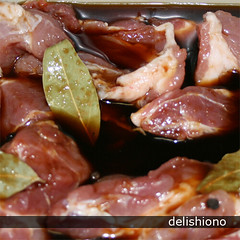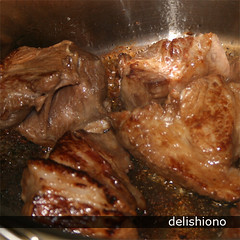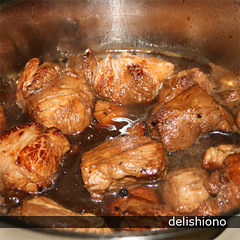My favorite get togethers involve food especially when someone else is cooking! Despite never having had "real" Osaka-style okonomiyaki (ie. in Osaka or Japan) I love the stuff. I've also found that it makes for a great "make-it-yourself" party food. Just prepare the batter, fillings and toppings ahead of time, set out hot plates and instructions and just let your friends cook their own damned food!
For an okonomiyaki party, I provide:
- Okonomiyaki batter
- Eggs
- Shredded cabbage and/or chopped kimchee
- Various batter add-ins, meats, toppings
Batter add-insI confess: I use a ready made mix for the okonomiyaki batter. Just add water. Since I've always done okonomiyaki for parties, I haven't really had the opportunity to experiment with non-ready made okonomiyaki mix lest it come out icky. The most important ingredient in the okonomiyaki batter is the 山いも (yamaimo) or mountain yam. It is what gives the okonomiyaki its texture and taste.Meat
- Cooked bacon bits (optional)
- Shredded cheese (optional)
- Baby shrimps (optional)
- Tenkasu/tempura bits (optional)
Toppings
- Bacon (thin sliced)
- Beef (thin sliced)
- Sausage (thin sliced)
- Spam (thin sliced)
- Okonomiyaki sauce
- Kewpie Mayonaise
- Aonori (seaweed flakes)
- Bonito flakes
- Chopped Green Onions (optional)
- Shoga (pickled ginger)
- Corn kernels
When looking for okonomiyaki batter mixes in your Japanese grocery store, look for it in the section that has other ready made mixes such as pancake mixes. (Don't substitute pancake mix for okonomiyaki mix. It's the wrong flavor and texture for this.) I've discovered that more general Asian markets tend not to have it in stock but it's always worth a shot if you don't have a Japanese grocery store near by. Always make sure that the mix includes "mountain yam" or "yamaimo" in the ingredients list. Otherwise, you won't have the same texture or flavor that you should.
If you don't have access to a Japanese grocery store to find okonomiyaki mix, Kirk of mmm-yoso has a great looking recipe that includes yamaimo here:
http://mmm-yoso.typepad.com/mmmyoso/2006/05/okonomiyaki.html
I've found that most general Asian markets will have "nagaimo" or "yamaimo" in stock in their fresh produce section. Where I am, they're usually packaged in pre-wrapped, single packages and may have a covering of sawdust on them.
Fillings and toppings are very much up to everyone's taste. At the very least, I provide green onions, okonomiyaki sauce and kewpie mayonaise. I have an indecent love for kewpie, as evidenced by the many times I've asked for extra mayo at Izumiya in San Francisco and consequently have been given a bowl to dip my okonomiyaki in. It sounds gross but I love it!
For parties, I've found it's good to either demonstrate or (if you have the time/energy/want to) you could print out instructions or designate a short-order chef. What follows are the instructions I wrote up for my latest okonomiyaki party (but didn't get to use) ;) Feel free to change it to suit your party.
* *
OKONOMIYAKI お好み焼き literally means "Grill as you like"
Here it means: Cook your own damned pancake! :)
Often compared to pizza for its customizability, okonomiyaki has several styles, depending on where in Japan you're eating. We're going to do the Kansai style of okonomiyaki which is basically a savory pancake filled with cabbage and other yummy things.
Step 1: Mixing it up!
Scoop a ladle full of batter into the bowl
Add one egg
Add some cabbage or kimchee (or both)
You can also add all/some/none of the optional filling ingredients to the batter.
- Bean sprouts
- Chopped Green Onions
- Cooked bacon bits
- Shredded chees
- Baby shrimp
- Chopped fake crab
- Tenkasu/tempura bits
If you find the mixture too thick and chunky, you can add more batter. It all depends on how much dough to filling you'd like.
Mix up the okonomiyaki batter, eggs and fillings in the bowl until well blended.
Step 2: Cooking It!
Oil up the ho
t plate with a good amount of cooking spray and spread the batter evenly.
While the batter is cooking, lay a few pieces of the meat (bacon, sausage, spam, etc.) onto the cooking pancake.
Let it cook on the first side for about 3 minutes and then flip (carefully) and cook on the other side for about 3 to 4 minutes to make sure that the meat is completely cooked. Feel free to squish the pancake every now and then to make sure it's cooked
Step 3: Topping it!
Once your okonomiyaki is cooked, remove it to a plate (I suggest meat side up) and start topping it.
Your choice of toppings are:
- Okonomiyaki sauce
- Kewpie Mayonaise
- Aonori (seaweed flakes)
- Bonito flakes
- Benishoga (pickled ginger)
- Corn kernels
For traditional Osaka-style okonomiyaki, top it with some okonomiyaki sauce and mayo and a sprinkling of aonori and bonito flakes. Watch as the bonito flakes start to move on their own from the heat. Oooh, spooky.
Otherwise, top to your hearts content and then pig out!
For the advanced folks - モダン焼き(modern yaki)
Fry up an okonomiyaki like you usually would
Next to it, fry up an over medium egg.
Remove the okonomiyaki to a plate. Top with a generous amount of yakisoba. Top the yakisoba with the egg. Top the egg with the various okonomiyaki toppings of your choice.
Pig out and then roll around in the blissful, carb induced coma that you'll find yourself in later.
